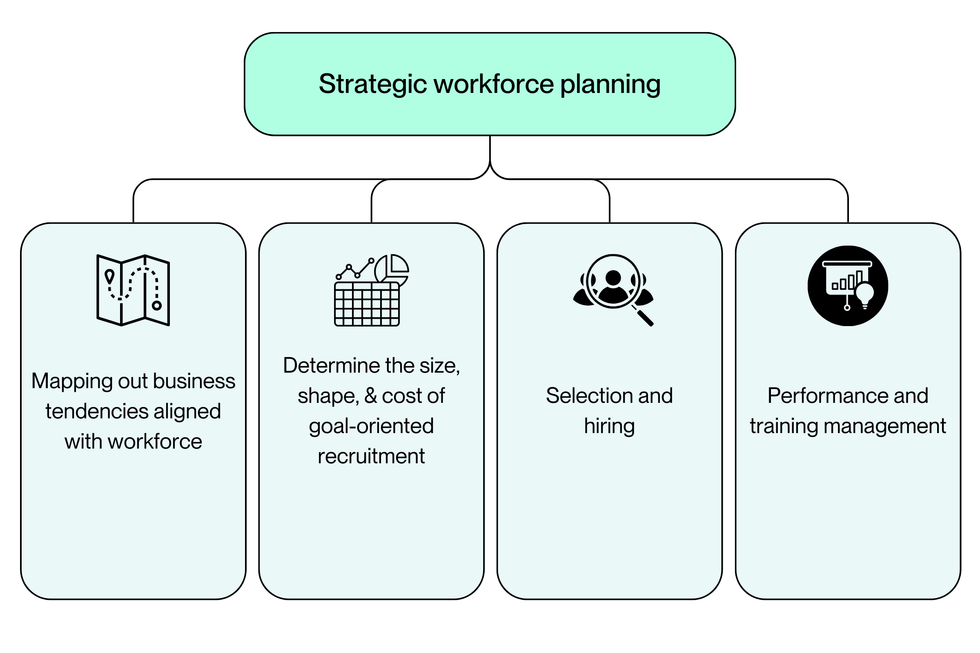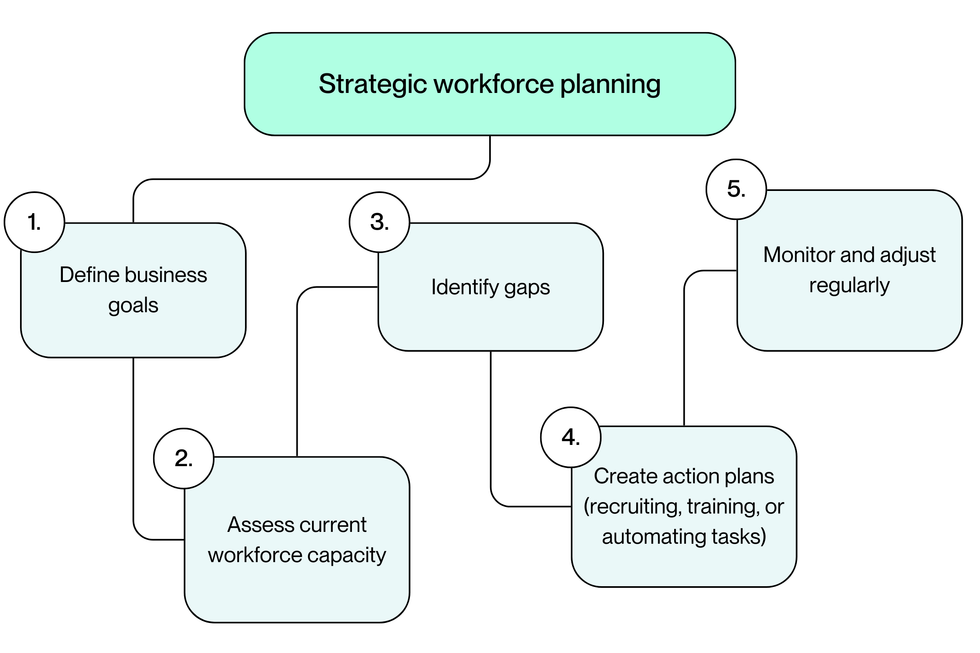Gallup reports that American businesses lose $450-500 billion a year because of disengaged or underutilized employees. That’s a lot of money that could have been used more productively and constructively! To utilize our human capital better, we have to start by asking: what is causing this massive scale of discontentment and unhappiness among employees? Bad bosses, improper goal setting, lack of inclusivity, and office politics — these are all just symptoms of a larger issue…improper workforce management. So how do we cure it? Strategic workforce planning.
On the surface, it might seem that employee and employer motivations are different, but they have much more in common than you might think! The big one is that both the employer and the employee are working to grow the business, and both are ultimately focused on delivering better performance. So if it feels like the employees aren’t synced with the employer’s vision, it’s probably exactly that! They’re not in sync, and strategic workforce planning can bring you better harmony.
What is strategic workforce planning?

Strategic workforce is about, well, strategy and workforce planning. But what does that actually mean? In practice, strategic workforce planning is the foresight and planning with which a business manages its biggest asset — human capital. Strategic workforce planning is what helps you nurture, grow, and tap into the fullest potential of your (literal) human resources.
We accomplish this by forecasting and proactively working on any talent, skill, or goal incompatibility an employee might face, and because it is inherently strategic, we have to establish a framework with proven methods first.
Read this next: Maximize your workforce with high-performing teams
There are three core elements in a workforce planning template:
1. Talent forecasting
Want to make sure your employees are the right fit for your vision? There are only two ways to do it: hire someone who’s already a fit, or upskill your current employees. The latter is typically more economical because hiring can be an expensive affair! And, not for nothing, but even when you can hire someone who’s already a fit, the world changes quickly enough that you’ll have to upskill that employee eventually anyway!
What you ultimately want is people who are willing to learn and grow with you and the business. So, if the goal is building a high-performance team, we have to first identify the skills that will get them there. This is talent forecasting, where you map out the skills you need from your employees — both current and in the near future. Talent forecasting also helps you understand where your team stands at the moment. This extensive exercise gives you a clear view of the competencies, gaps, and opportunities your workforce currently has.
Read this next: How to get started with talent density for your teams
2. Gap analysis
You want to find the gap — the skills gap — as soon as possible.
Any time spared is time and money wasted. But how on earth do you find the gap? You need a skills audit!
A skills inventory doesn’t just tell you where your team lacks skills (the gap) but also what they’re already good at. These are both equally important pieces of information and will help you make a plan that naturally works for your employees.
Read this next: How to conduct a skills inventory of your team for growth
3. Resource allocation
The third element is all about using what you’ve got and figuring out what new tools you might need. You’ve identified what you need from your employees, and you have identified where their skill gap is, so now it’s time to bridge that gap! This might involve something as simple as switching to a better piece of software that helps your employees save time by automating repetitive tasks, or committing to an upskilling exercise by providing them:
- Cross-departmental opportunities,
- Enrolling your workforce in new courses, seminars, and workshops to help them gain new skills.
- Creating a virtual peer support and accountability group to check progress.
Now is the time you could also consider fresh recruitment to fill those gaps, but the idea here isn’t to increase the size of the workforce, rather increase the merit and quality of your team. Building a high-talent-density workforce isn’t a new concept.
Read this next: Building lean teams 101
For a strategy that works for your business, you can start with this workforce planning template:

- Define business goals: Strategic workforce planning begins with clarity about your business goals. Are you aiming to increase revenue, enter a new market, or improve customer retention? By understanding your long-term goals, you can identify the specific roles, skills, and behaviors required to achieve them, ensuring that your workforce planning efforts are targeted and impactful.
- Assess current workforce capacity: To effectively plan, you need an accurate understanding of your current workforce's capabilities. This involves evaluating your team’s existing skills, strengths, and performance levels. A detailed skills inventory or assessment can help you uncover areas where your team excels and where improvement is needed.
- Identify gaps: Once you’ve defined your goals and assessed your workforce, the next step is to identify gaps between what you need and what you have. This includes skill gaps, capacity shortfalls, and even behavioral or cultural mismatches that could hinder progress.
- Create action plans (recruiting, training, or automating tasks): With a clear understanding of your goals and gaps, you can develop a strategic action plan to bridge those gaps. This might involve recruiting new talent to fill critical roles, investing in upskilling programs to enhance your current team’s capabilities, or introducing automation tools to streamline repetitive tasks.
- Monitor and adjust regularly: Workforce planning isn’t a one-and-done exercise — it requires continuous monitoring and adaptation. As business priorities shift or market conditions change, your workforce strategy must evolve to stay aligned. Regularly review your progress, reassess your workforce needs, and make adjustments to your plans to ensure long-term success.
McKinsey’s Three Horizons Model
There are many models and ways to go about strategic workforce planning. But none of them marry strategy and workforce planning quite as efficiently as the Three Horizons Model. Fortunately, we think it’s pretty simple to understand, too! The Three Horizons Model of strategic workforce planning uses time as the compass to steer the business with relevant goals and strategies.
Start by drawing time out in three distinct horizons: the present, the short-term future, and the long-term future. Then, one by one, you carefully evaluate the needs and action points for each horizon. Remember, we plan for all three horizons together, but prioritize the first horizon’s activities.
The first horizon deals with immediate needs such as how to reduce attrition, address recent openings, maximizing productivity, or planning on conducting a skills audit. This is the horizon that needs to be planned with the most details.
Then comes the second horizon, which deals with short- to medium-term business goals. The time frame here is within three to five years from when you begin planning — you’ll want to try and anticipate any threats or opportunities that your workforce may encounter, include your plans to scale the business up, add new departments or roles, any significant working mode transitions (from on-site to remote), or technological innovations you may want or need.
The last horizon is the one that is more tied to your end goal and vision for the business. Since it is so far out into the future (5-10 years), meticulous planning for this horizon is difficult and may never actually actualize. However, this just means that this is the horizon where we have more leeway to be ambitious, to plan for future projects, experimentation, and account for management-level changes.
It’s crucial to do all three horizons simultaneously, but follow the 70-20-10 rule! Horizon one gets 70% of your attention, horizon two gets 20%, and horizon three gets 10%. This helps you and your business effectively balance short-term and long-term goals while also ultimately adapting the path of the greatest good for that vision.
Best practices for strategic workforce planning
Involve all leadership and HR stakeholders in the conversations
Strategic workforce planning only works if you involve the relevant people right away at the planning stage, so when you are working on creating a strategic workforce plan, ensure your strategy leaves no one out. It has to center around the employees and factor their interests and goals in, but it also has to include the leadership — from the individual contributors to the CEO — to help guide the business toward its ultimate long-term goals. And, of course, since the HR team will end up being the bridge between the stakeholders, they’re one of the most important stakeholders!
This stage can be tricky since all the parties involved have their own requirements and concerns. How does one strike this conversation and make a plan conducive to everyone’s growth? You know we’ve got you covered!
Read this next: Why communication style matters for business
Prioritize agility & flexibility
Even with a solid bulletproof plan, things can always take an unexpected turn. Sometimes for good, and sometimes not! In case you’re met with inconvenience or obstacles while implementing this plan, what do you do? Abandon it? Absolutely not!
Tweaking is much faster and much more feasible. So, when you are strategizing your own workplace management template, make sure to keep some room for error. A little margin that allows you to maneuver, customize, and course-correct without (much) pain.
Read this next: 10 lessons on continually evolving your business
Focus on employee retention
Did you know hiring is at least 70% more expensive than retaining? Yup! Right at the onset of this blog we told you that strategic workforce planning explicitly doesn’t aim to shelve or replace the current workforce. Rather, it nurtures and grows the existing talent with more skills and tools.
Yes, business needs evolve and new hiring may be the only solution at times, but it shouldn’t be your go-to first solution. The idea behind this whole exercise is to improve company profitability and make your people a long-term culture and performance fit, and that means strategic hiring decisions too!
Ideally, workforce planning strategies create new opportunities for the employees to grow and advance in their careers within the organization.
Watch this next: Unlocking Potential: The Role of Career Advancement & Growth in Employee Retention





